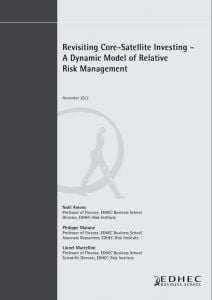

Revisiting Core-Satellite Investing - A Dynamic Model of Relative Risk Management
Tracking error is not necessarily bad. Just like with good and bad cholesterol, there is “good” tracking error, which refers to out-performance of a portfolio with respect to the benchmark, and “bad” tracking error, which refers to underperformance with respect to the benchmark. By severely restricting the amounts invested in active strategies as a result of tight tracking error constraints, investors forgo an opportunity for significant out-performance, especially during market downturns. In this paper, the authors introduce a new methodology that allows investors to gain full access to good tracking error, while maintaining the level of bad tracking error below a given threshold. A revisited version of this paper was published in the Fall 2004 issue of The Journal of Portfolio Management.
Author(s):
Summary:
Tracking error is not necessarily bad. Just like with good and bad cholesterol, there is “good” tracking error, which refers to out-performance of a portfolio with respect to the benchmark, and “bad” tracking error, which refers to underperformance with respect to the benchmark. By severely restricting the amounts invested in active strategies as a result of tight tracking error constraints, investors forgo an opportunity for significant out-performance, especially during market downturns. In this paper, the authors introduce a new methodology that allows investors to gain full access to good tracking error, while maintaining the level of bad tracking error below a given threshold. A revisited version of this paper was published in the Fall 2004 issue of The Journal of Portfolio Management.
Register to download PDF
Register/Log in| Type : | Working paper |
|---|---|
| Date : | 11/05/2012 |
| Keywords : |
Asset Allocation |

